Over the past few decades, old man’s beard (OMB) has rapidly spread to many parts of Tasman, and continues to do so at an alarming rate. OMB has become so widespread that there are now literally billions of seeds released every year in Tasman. The fluffy tail attached to each seed allows it to blow a significant distance from the parent plant. These seeds unfortunately can remain viable for 10 years. Compared to other pest vines, the impact of old man’s beard on the environment has been rapid and significant, particularly considering it has only been present in New Zealand since the early 1920s. This smothering vine is a substantial threat to Significant Natural Areas and the annual cost of control around the country is in the millions of dollars.
There are still some places in Tasman where old man’s beard is largely absent, such as Golden Bay/Riuwaka and the St Arnaud/Upper Buller areas. In these areas, it is described as a Sustained Control pest in the Tasman-Nelson Regional Pest Management Plan. This pest status requires landowners/occupiers to control old man’s beard each year before seeding occurs. The amount of old man’s beard present in the rest of Tasman and Nelson and the way that it spreads means that eradication is not achievable - it is already ‘out the gate’, as they say.
Old Man’s Beard Biocontrol Agents
In the UK, OMB is native to that environment and is known as ‘travellers joy’. It is not considered a problem there as it is subject to attacks from pathogens, fungi, insects and other organisms, which assist greatly in keeping the vine in check. Some of these damaging organisms have been selected by biocontrol scientists for their suitability as potential biocontrol agents in New Zealand.


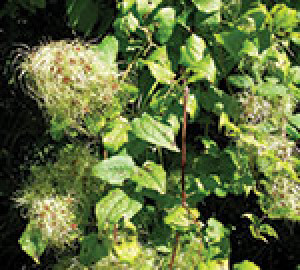
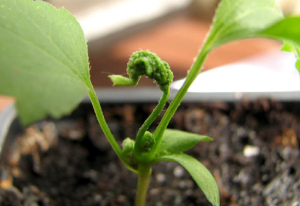 These microscopic mites cause OMB to create galls that inhibit the vascular flow through to growing shoots. Trials were undertaken in Serbia and the mites proved to be very host specific. The mite has shown no interest in 14 species of New Zealand native clematis, but has damaged OMB from New Zealand. After trials at the Lincoln Research Centre were completed in 2018, the EPA approved the release of these mites in to the wild.
These microscopic mites cause OMB to create galls that inhibit the vascular flow through to growing shoots. Trials were undertaken in Serbia and the mites proved to be very host specific. The mite has shown no interest in 14 species of New Zealand native clematis, but has damaged OMB from New Zealand. After trials at the Lincoln Research Centre were completed in 2018, the EPA approved the release of these mites in to the wild.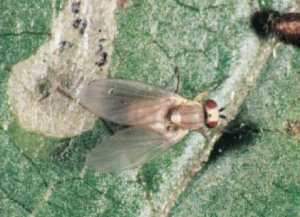 OMB leaf miner was the first organism considered for the biocontrol of OMB. It is a small fly 1 –2 mm long and is native to Europe. Flies were imported from Switzerland to NZ for testing in 1994, and New Zealand releases in to the wild began in 1996. The fly’s maggots inflict damage by tunnelling between the top and bottom of the leaves, and it is now very common throughout New Zealand. Unfortunately, six native and two exotic parasitoids generally keep the OMB leaf miner populations lower than the threshold needed to impact on the growth of the vine.
OMB leaf miner was the first organism considered for the biocontrol of OMB. It is a small fly 1 –2 mm long and is native to Europe. Flies were imported from Switzerland to NZ for testing in 1994, and New Zealand releases in to the wild began in 1996. The fly’s maggots inflict damage by tunnelling between the top and bottom of the leaves, and it is now very common throughout New Zealand. Unfortunately, six native and two exotic parasitoids generally keep the OMB leaf miner populations lower than the threshold needed to impact on the growth of the vine.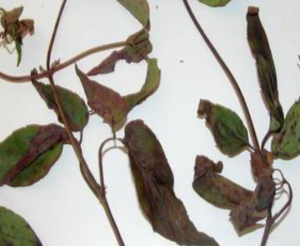 A superior strain of a fungus (Phomaclematidina) was released in 1996. This fungus was already present in New Zealand, but the superior strain was expected to impact more aggressively on leaves. Initially, heavy damage was observed at release sites, but this did not persist. Subsequent studies could find no trace of the released strain, and it is possible that it was outcompeted by other fungi on OMB. This fungus was released in the Sherry River area in 2006.
A superior strain of a fungus (Phomaclematidina) was released in 1996. This fungus was already present in New Zealand, but the superior strain was expected to impact more aggressively on leaves. Initially, heavy damage was observed at release sites, but this did not persist. Subsequent studies could find no trace of the released strain, and it is possible that it was outcompeted by other fungi on OMB. This fungus was released in the Sherry River area in 2006.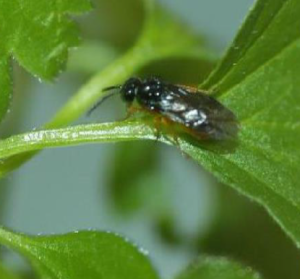 The OMB saw fly is native to Europe but is uncommon there. Although it proved difficult to mass-rear in New Zealand, enough were available for releases at sites in Otago and the Bay of Plenty in 1998. No surviving population was detected one year on. This fly damages the leaf stem by cutting through it.
The OMB saw fly is native to Europe but is uncommon there. Although it proved difficult to mass-rear in New Zealand, enough were available for releases at sites in Otago and the Bay of Plenty in 1998. No surviving population was detected one year on. This fly damages the leaf stem by cutting through it.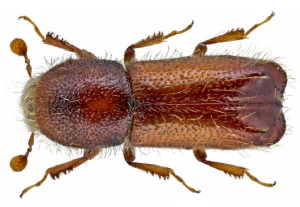 The clematis bark beetle is known to regularly kill whole vines in Europe and is possibly a key control species responsible for keeping vines in check in Europe. New Zealand native clematis was sent to the U.K. for field trials, and beetles were imported to New Zealand (Lincoln Research Centre) for further testing in 2017. Unfortunately, the trials showed the beetles had no specific clematis feeding preferences and eagerly feasted on New Zealand native clematis species as well as OMB. As a result of this, the project was aborted.
The clematis bark beetle is known to regularly kill whole vines in Europe and is possibly a key control species responsible for keeping vines in check in Europe. New Zealand native clematis was sent to the U.K. for field trials, and beetles were imported to New Zealand (Lincoln Research Centre) for further testing in 2017. Unfortunately, the trials showed the beetles had no specific clematis feeding preferences and eagerly feasted on New Zealand native clematis species as well as OMB. As a result of this, the project was aborted.